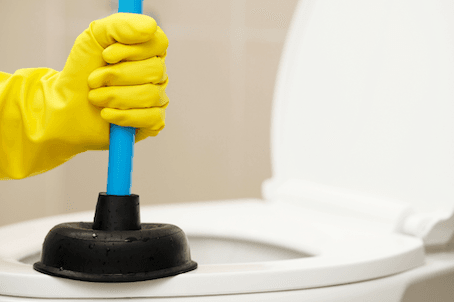To maintain an efficient and hygienic bathroom, you should replace your toilet plunger every 6 months to 1 year. Look for signs like cracks, loss of suction, mold, and handle damage to know when it’s time for a replacement.
Factors such as frequency of use, type of plunger, and maintenance practices influence how often you should replace it. Regular cleaning and proper storage can extend the plunger’s lifespan.
By recognizing the signs that indicate it’s time for a new plunger and knowing the factors that affect its longevity, you can ensure you always have an effective tool on hand.
Toilet plungers are essential tools in every household for dealing with clogs. However, an old or damaged plunger can be ineffective and frustrating to use, leading to prolonged clogs and unsanitary conditions.
This guide will explore how frequently you should replace a toilet plunger, covering the key factors and best practices for maintaining this essential tool. By the end of this, you’ll know how to keep your bathroom functional and clean with an effective plunger.

How Often Should You Replace a Toilet Plunger?
Replacing your toilet plunger regularly ensures effective use when you need it most. Over time, plungers can wear out due to frequent use and exposure to moisture and chemicals.
It’s generally recommended to replace your toilet plunger every 6 months to 1 year, depending on usage frequency and maintenance. Regular replacement helps maintain cleanliness and ensures the plunger’s suction power remains strong.
Signs That Indicate It’s Time to Replace Your Toilet Plunger
Knowing when to replace your toilet plunger is important to maintaining a smoothly running household and preventing unexpected plumbing emergencies. A worn-out plunger can lead to frustration when it fails to clear a stubborn clog effectively.
Look out for these signs to determine if it’s time for a replacement:
- Cracks or Tears: Inspect the rubber suction cup of your plunger. Cracks or tears can diminish effectiveness, making it difficult to seal and clear clogs properly.
- Loss of Suction: If the plunger no longer provides strong suction when pressed against the toilet drain, it may be worn out and need replacement. This loss of suction can indicate that the rubber has become hardened or worn down over time.
- Mold or Mildew: Despite regular cleaning, plungers can harbor mold or mildew, especially in cracks or crevices. If you notice persistent mold growth or an unpleasant odor even after cleaning, it’s time for a new plunger. This is to maintain hygiene and prevent contamination.
- Handle Damage: Check the handle for cracks or breakage. A damaged handle compromises your ability to apply sufficient force when plunging, reducing its effectiveness in clearing clogs.
- Age: Even with careful use, toilet plungers have a lifespan due to exposure to water and chemicals. If yours is several years old and showing signs of wear, consider replacing it to ensure reliable performance during emergencies.
Factors Influencing Plunger Replacement Frequency
Several factors play a role in determining how often you should replace your toilet plunger. Knowing these factors can help you maintain a functional and hygienic bathroom environment:
- Frequency of Use: Plungers used frequently wear out faster. If you often experience toilet clogs or have a large household, consider replacing the plunger every 6 months to 1 year to maintain its effectiveness.
- Type of Plunger: Different types of plungers (such as flange, accordion, or bellows-style plungers) have varying durability and maintenance needs. Check manufacturer guidelines for recommended replacement intervals based on the type of plunger you use.
- Maintenance: Regular cleaning and proper storage can extend the lifespan of your plunger. Rinse the plunger thoroughly after each use and store it in a dry place to prevent bacterial growth and deterioration of the rubber suction cup.
- Hygiene Concerns: Plungers are in direct contact with toilet water and can harbor bacteria, even with regular cleaning. Replacing them periodically helps maintain bathroom hygiene standards and reduces the risk of cross-contamination.
- Quality: Higher quality plungers made from durable materials may last longer than cheaper alternatives. Invest in a quality plunger with a strong suction cup and sturdy handle for longer-lasting performance and fewer replacements over time.
Tips for Extending Plunger Lifespan
Ensuring your toilet plunger remains effective when tackling bathroom clogs is practical and saves you from unexpected plumbing hassles.
Here are some simple yet effective tips to help you prolong the lifespan of your plunger:
- Regular Cleaning: Proper maintenance starts with regular cleaning. After each use, thoroughly rinse the plunger with hot water to remove any residue and prevent bacterial buildup.
- Proper Storage: Where you keep your plunger matters. Store it in a dry, well-ventilated area to prevent mold and mildew growth and ensure it’s ready for the next use.
- Inspect and Maintain: Regularly inspect the plunger for signs of wear and tear, such as cracks in the rubber or damage to the handle. Addressing these issues promptly, including replacing the plunger seal if necessary, can prevent further deterioration.
- Avoid Harsh Chemicals: Harsh chemicals can degrade the rubber of your plunger, reducing its effectiveness over time. Stick to mild cleaners or natural solutions to preserve its suction power.
- Invest in Quality: Quality matters when it comes to plungers. Investing in a durable, well-made plunger can save you from frequent replacements and ensure reliable performance. Consider heavy-duty plunger options for long-lasting and effective results.
Knowing when and how often to replace your toilet plunger is important for maintaining a functional bathroom and preventing plumbing issues. Overall, taking these steps will help you handle toilet clogs efficiently and maintain a clean bathroom environment.
